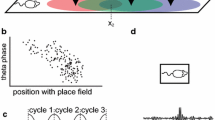Abstract
Investigations of the neuronal activity of the cerebral cortex of monkeys during the performance of a delayed spatial choice made it possible to formulate an hypothesis regarding the neuronal systems providing for operative memory. One system functions on the principle of relay race-reverberation transmission of information. During the action of a sensory signal a population of spatially selective “sensory” neurons is excited. By the delay period (operative memory) this information is transmitted to a population of “memory” neurons. The delay period is quantized in time segments in the course of which individual populations of cells are involved in relays in the reverberation activity. Each of these populations comprises a “neuronal trap” in which the excitation circulates for 1.5–2 sec. At the end of the delay period switching of the excitation to a different population of cells takes place, which are associated with the preparation of a goal-directed movement (the “neurons of the motor programs”). Another system of neurons assures the reliability of the transitional phases of the above-named processes, specifically: 1) of the switchings of information from the “sensory” neurons to the “memory” neurons and subsequently to the neurons of the “motor programs”; 2) the reflection of the entire period of operative memory without relay race-reverberation; and 3) the preservation of the signal information in the activity of a unified neuronal population right up to the moment of the performance of the goal-directed movement.
The above-designated systems are represented variously in the associative (frontal and parietal) zones of the neocortex.
Similar content being viewed by others
References
A. S. Batuev, G. P. Dem'yanenko, A. A. Orlov, and V. J. Shaefer,Neuronal Mechanisms of the Awake Brain of Monkeys [in Russian], Nauka, Leningrad (1988).
A. S. Batuev,Higher Integrative Systems of the Brain, Gordon and Breach, N.Y. (1987).
A. S. Batuev, “Neuronal mechanisms of short-term memory,”Soc. Sci. Rev. F. Physiol. Gen. Biol,4, 53–93 (1990).
A. S. Batuev, A. A. Orlov, and A. A. Pirogov, “Short-term spatiotemporal memory and cortical unit reactions in the monkey,”Acta Physiol. Hung.,58, 207–217 (1981).
A. S. Batuev, A. A. Orlov, and V. J. Shaefer, “Comparative characteristics of unit activity in the prefrontal and parietal areas during delayed performance in monkeys,”Behav. Brain Res.,16, No. 1, 57–70 (1985).
J. C. Eccles, “The modular operation of the cerebral neocortex considered as the maternal basis of mental events,”Neuroscience,6, No. 10, 1839–1855 (1981).
J. M. Fuster,The Prefrontal Cortex. Anatomy, Physiology and Neuropsychology of the Frontal Cortex, Raven Press, New York (1980).
J. Hyvarinen,The Parietal Cortex of the Monkey and Man, Springer, Berlin (1982).
R. Kubota, T. Iwamoto, and H. Suzuki, “Visuokinetic activities of primate prefrontal neurons during delayed response performance,”J. Neurophysiol.,37, No. 6, 1197–1212 (1974).
N. Niki, “Differential activity of prefrontal units during right and left delayed response trials,”Brain Res.,70, No. 2, 346–349 (1974).
H. Sakata, H. Shibutani, K. Kawana, “Spatial properties of visual fixation neurons on posterior parietal association cortex in the monkey,”J. Neurophysiol.,43, No. 6, 1654–1672 (1980).
Author information
Authors and Affiliations
Additional information
Translated from Zhurnal Vysshei Nervnoi Deyatel'nosti imeni I. P. Pavlova, Vol. 41, No. 6, pp. 1088–1093, November–December, 1991.
Rights and permissions
About this article
Cite this article
Batuev, A.S. An hypothesis regarding the cortical mechanisms of operative memory. Neurosci Behav Physiol 23, 130–134 (1993). https://doi.org/10.1007/BF01189109
Received:
Revised:
Issue Date:
DOI: https://doi.org/10.1007/BF01189109




